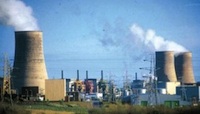
The proposed designs for seven new British nuclear power stations, which will be built along the Irish Sea coast, have potentially lethal flaws, according to official documents.
The British government unveiled its nuclear plans last month, just weeks after regulators in four countries issued safety alerts about the proposed designs.
Nuclear safety regulators in the US, Britain, France and Finland all have expressed doubts about their emergency control systems and their vulnerability to attack.
The plants, which will open from 2018, are being built using a controversial fast-track planning system where their operators will choose from two pre-approved power station designs. They can then build the plants without any further safety checks.
The two rival designs, which are being developed by US firm Westinghouse and French company Areva, have both encountered similar safety problems.
Last month, US regulators rejected the design of the Westinghouse reactor’s shield, which is supposed to protect it from adverse weather conditions and terrorist attack, after it failed basic checks.
According to Michael Johnson, the director of the US Nuclear Regulatory Commission’s office of new reactors, the rejection came after a year of negotiations with Westinghouse regarding its design.
“This is a situation where fundamental engineering standards will have to be met before we can begin determining whether the shield building meets the agency’s requirements,” he said.
Meanwhile, Areva’s European Pressurised Reactor (EPR) was criticised by the British, French and Finnish nuclear regulators earlier this month. In a joint statement, they ruled that the design’s safety back-up systems were insufficiently independent of its normal control systems.
“Independence is important because, if a safety system provides protection against the failure of a control system, then they should not fail together. The EPR design doesn’t comply with the independence principle, as there is a very high degree of complex interconnectivity between the systems,” it said.
Areva has also struggled to produce a design which could withstand an attack, resulting in numerous delays at its pilot plant at Olkiluoto in Finland.
British nuclear plants have a history of major accidents and scandals.
A fire broke out in Sellafield that burned for three days in 1957. After that a cloud of smoke was believed to be the cause of an outbreak of illness among some of the pupils in St. Louis Girls’ School, Dundalk, just across the Irish Sea.
The number of births of children with Down Syndrome has increased four-fold in the town in the last 35 years.
Dr. Patricia Sheehan found that there was an extraordinarily high rate of still-births, miscarriages, early childhood deaths, spina bifida and Down Syndrome in babies that were born to women who had been St. Louis’ pupils in 1957.
In 2005, the leak of 20 tonnes of plutonium and uranium liquid mixed with nitric acid was discovered at Sellafield’s Thorp reprocessing facility. It had been undetected for nine months.
Louth TD Fergus O’Dowd, a leading anti-nuclear campaigner, said he was stunned by the new revelations, particularly as all seven proposed plants are directly across the sea from major Irish centres of population.
“These are all extremely serious issues, which I will be taking up with the Radiological Protection Institute and the government. Our concerns are being ignored and it seems that these plants are in a fast track process which is fundamentally flawed,” he said.
“This needs to be raised as a matter of urgency by Brian Cowen directly with the British prime minister Gordon Brown. This is such a serious issue that it has to be addressed at the highest intergovernmental level.”
![[Irish Republican News]](https://republican-news.org/graphics/title_gifs/rn.gif)
![[Irish Republican News]](https://republican-news.org/graphics/title_gifs/harp.gif)

